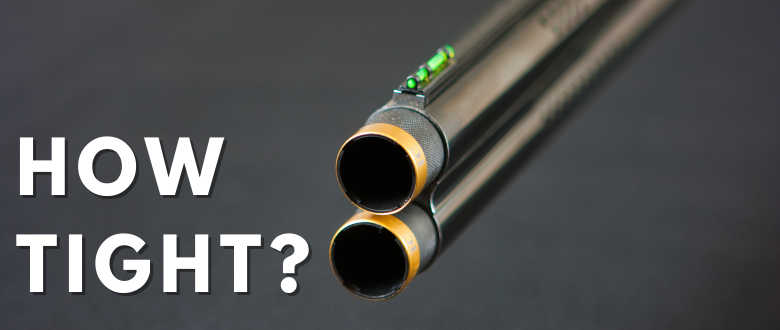↬ A choke tube tightens by being rotated clockwise so that the threads between it and the barrel of the shotgun create a tight fit. Knowing how tight a choke should be is key to installing a choke tube correctly so that it performs effectively.
A choke tube should be hand tight with enough force applied to keep the threads from backing out of the shotgun barrel. Tightening it until resistance and then applying a 1/8 inch more turn is usually enough. A choke tube should never be over-tightened.
Over-tightening can cause the choke threads to be stripped or damaged. Other issues like choke tube gap and a chokes refusal to sit flush with the barrel are signs that debris or other factors are causing the choke threads to bind.
![]()

How Tight Should Choke Tubes Be?
Choke tubes should be screwed on so that the threads are completely mated and there is no gap between the choke tube and the end of the shotgun barrel. The force applied to tighten a choke tube should be applied by hand with moderate pressure, but not so much that it causes the threads to strip or become damaged.
Every part of every shotgun should be tightened sufficiently, not just the choke. Take note that a choke does not need to be tightened too much. You can just tighten them enough that they will be hand tight without backing out.
SUMMARY
A choke tube should be hand tight without applying too much torque. Usually a 1/8 inch turn past resistance is enough. Treat it like tightening the oil drain bolt on your truck. Hand tight is enough and never go overboard.
How To Tell Your Choke Tube Is Tight Enough?
A good rule of thumb for gauging the tightness is to turn the choke clockwise until you feel resistance and then turn it 1/8 inch more. Tightening it by hand allows the choke to be secure while making it easy to remove later if you need to.
Choke wrenches make tightening choke tubes easier since they grip the choke and apply torque for extra tightness. They can also help grip stuck choke tubes to break them free.
Can Over-Tightening Choke Tubes Cause Problems?
Over-tightening a choke tube can cause a host of problems so it’s important you get it right. Below are the top 3 issues that can arise from over-tightening a choke.
1. You Can Strip The Threads
Tightening a choke too much can cause the threads to be stripped. This won’t allow the choke to tighten properly and it will either need to be rethreaded or replaced.
2. The Choke Tube Can Be Damaged
Similar to stripping the threads, over-tightening can damage the outer walls of the choke if too much torque is applied. This can cause the walls of the choke to collapse and become unusable.
3. It Can Be Difficult To Remove
If too much torque is applied, the choke tube can become fused with the barrel threads. This will make it impossible to backout or require a choke wrench or extractor tool to break it free. Hand tightening is always the best way to avoid these conditions.

Can Under-Tightening Choke Tubes Cause Problems?
Under-tightening a choke tube is also a problem, and it can lead to sub-optimal conditions that can affect performance in the field. Patterning and pellet distribution can suffer from an under-tightened choke tube. Here are the 4 major problems that can arise from an under-tightened choke.
1. It May Back Out of the Gun
A loose choke tube that is not sufficiently tightened can back out of the barrel. Chokes tubes can back out or unscrew just by the force from the shot, so not tightening it enough can exacerbate this situation.
2. Performance Issues
A choke tube that isn’t tight means that threads inside the barrel could be exposed. A gap inside the barrel can cause performance issues with the shot column as it exits the choke. Shotgun patterns could suffer because of it.
3. Frequent Re-Tightening
If the proper torque isn’t applied to seat the choke tube, it could require frequent re-tightening. This could be as often as after every shot or every 10 shots. Regardless, you’ll be constantly re-tightening if it’s not seated properly.
4. You Can Damage the Threads
Exposed threads from a choke backing out of the shotgun can lead to thread damage (which can be permanent). This constant shifting due to looseness can lead to thread degradation of time.
If a choke becomes damaged or will not seat properly, it should be replaced. If you need a new choke, start your search here.
Bottom Line: A Choke Should Be Hand Tight
A choke should be hand tight and once resistance is met, a 1/8 inch turn should seal it in place. A handy choke wrench is the best tool for tightening choke tubes. Don’t over-tighten or under-tighten a choke because it can lead to performance issues.
If you’re unsure about how tight a choke should be, always settle for hand tight first with moderate pressure and reassess after a couple of shots. This is will let you know what the acceptable tightness is for future use.
Finally, if you experience a choke not sitting flush or a gap with the shotgun barrel, inspect the threads for debris that could be causing it to bind. Cleaning chokes with the proper tools, as well as lubricating them is always best practice to achieve optimal performance.
Was this helpful?
![]()
Search Chokes by Gauge
Latest Posts
- Best Waterfowl Choke Tubes for 2024, Expert Picks

- Choke Tube Diameter and Constriction Table

- 5 Easy Ways to Remove a Stuck Choke Tube

Last update on 2025-12-04 / Affiliate links / Product Images from Amazon Product Advertising API






